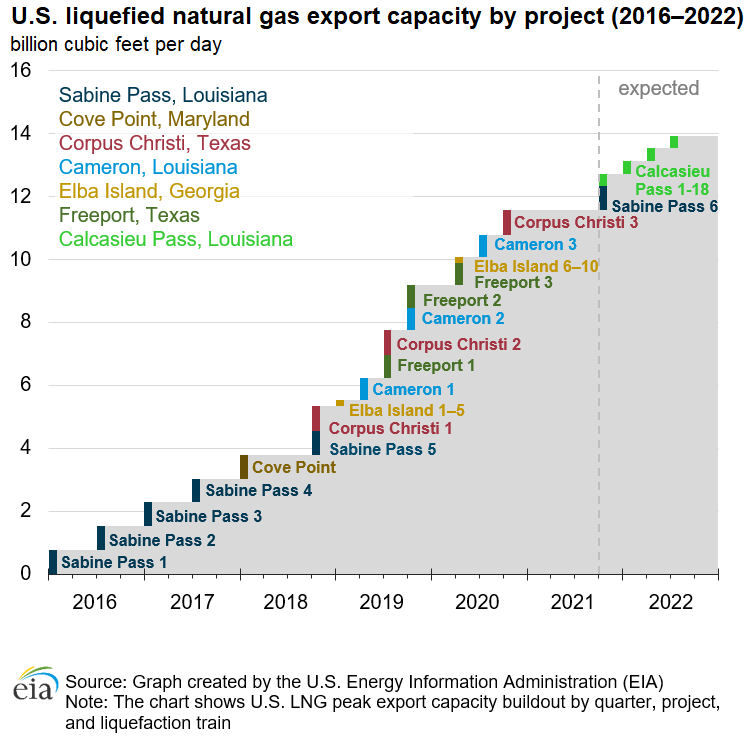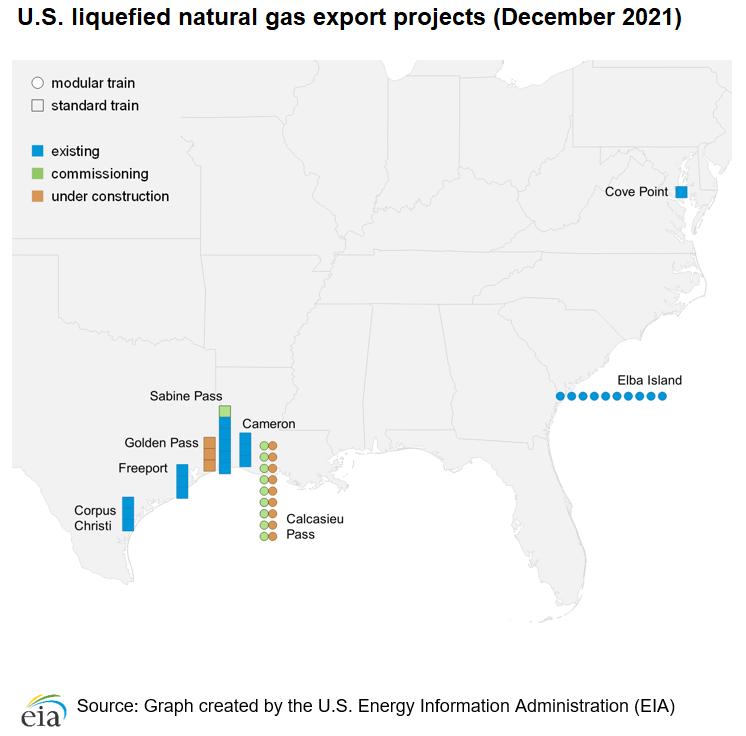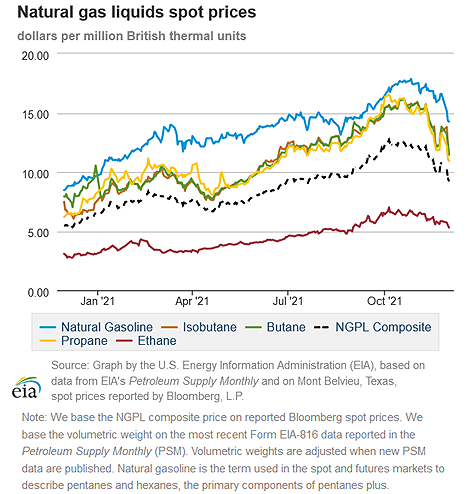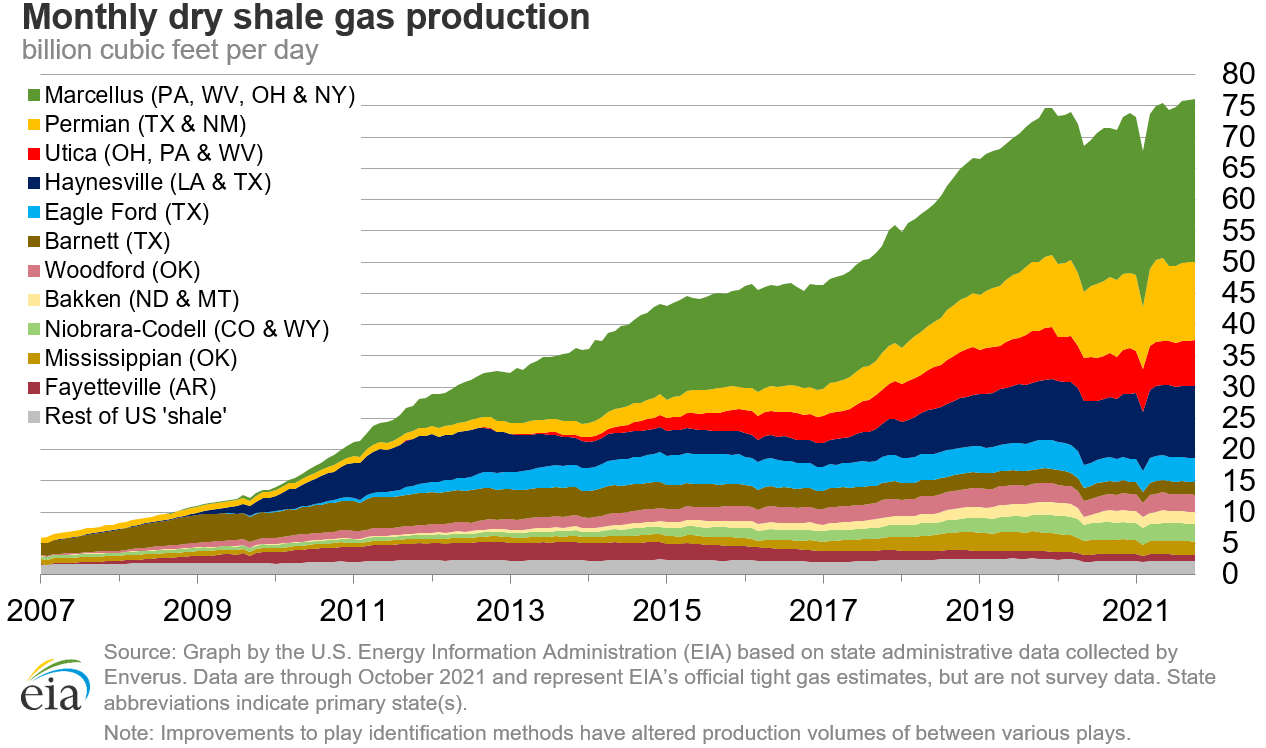In the News:
On completion of planned projects, U.S. LNG export capacity will be the world’s largest in 2022
Since exports of liquefied natural gas (LNG) began from the Lower 48 states in February 2016, U.S. LNG export capacity has grown rapidly. Within four years, the United States became the world’s third-largest LNG exporter behind only Australia and Qatar. Once the new LNG liquefaction units (called trains) at Sabine Pass LNG and Calcasieu Pass LNG are placed in service in 2022, U.S. LNG export capacity will become the world’s largest.
According to announced project plans, the following U.S. LNG export capacity expansions will occur between December 2021 and fall 2022:
- Completion of Train 6 at the Sabine Pass LNG export facility. Train 6 will add up to 0.76 billion cubic feet per day (Bcf/d) of peak export capacity. Train 6 began producing LNG in late November and the first export cargo from this train is expected to be shipped before the end of this year.
- Increase in LNG production at Sabine Pass and Corpus Christi LNG terminals as a result of optimizing operations. The U.S. Federal Energy Regulatory Commission (FERC) approved an increase in annual LNG production at these two facilities by a combined 261 billion cubic feet per year (Bcf/y) or 0.7 Bcf/d (11.5%) through uprates and modifications to maintenance. Individually:
- FERC granted approval to increase LNG production at Sabine Pass LNG from 1,509 Bcf/y to 1,662 Bcf/y across six liquefaction trains, an increase of 10%.
- FERC approved an LNG production increase at Corpus Christi LNG from 767 Bcf/y to 875 Bcf/y across three trains currently in operation, an increase of 14%.
- New LNG export facility Calcasieu Pass LNG in Louisiana comes online. The project consists of 9 blocks, each containing 2 mid-scale modular liquefaction units for a total of 18 liquefaction units with a combined peak capacity of 1.6 Bcf/d. Commissioning activities at Calcasieu Pass LNG started in November 2021, and the first LNG production is expected before the end of this year. All units are expected to be placed in service by the fourth quarter of 2022.
We estimate that as of November 2021, existing U.S. LNG nominal baseload liquefaction capacity was 9.5 Bcf/d and peak capacity was 11.6 Bcf/d (which includes uprates to LNG production capacity at Sabine Pass and Corpus Christi). By the end of 2022, U.S. nominal capacity will increase to 11.4 Bcf/d and peak capacity to 13.9 Bcf/d across 7 LNG export facilities and 44 liquefaction trains, including 16 full-scale, 18 mid-scale, and 10 small-scale trains at Sabine Pass, Cove Point, Corpus Christi, Cameron, Elba Island, Freeport, and Calcasieu Pass. In 2022, U.S. LNG export capacity will exceed that of the two current largest global LNG exporters, Australia (11.4 Bcf/d) and Qatar (10.3 Bcf/d). By 2024, when Golden Pass LNG—the eighth U.S. LNG export facility—completes construction and begins operations, U.S. LNG peak export capacity will further increase to an estimated 16.3 Bcf/d.
In addition, FERC and the U.S. Department of Energy have approved another 10 U.S. LNG export projects and capacity expansions at 3 existing LNG terminals—Cameron, Freeport, and Corpus Christi—totaling 25 Bcf/d of new capacity. Developers of some of these projects announced plans to make a final investment decision (FID) in 2022.
Overview:
(For the week ending Wednesday, December 1, 2021)
- Natural gas spot prices fell at most locations this report week (Wednesday, November 24 to Wednesday, December 1). The Henry Hub spot price fell from $4.90 per million British thermal units (MMBtu) last Wednesday to $4.23/MMBtu yesterday.
- International natural gas prices were at or close to all-time highs this report week. Bloomberg Finance, L.P. reports that swap prices for liquefied natural gas (LNG) cargos in East Asia for the balance of the month (December) remained relatively flat at $36.47/MMBtu this report week, the highest weekly average on record going back to January 2020. At the Title Transfer Facility (TTF) in the Netherlands, the most liquid natural gas spot market in Europe, the day-ahead price rose for the fourth week in a row to a weekly average of $30.67/MMBtu, up $1.21/MMBtu from last week’s average of $29.46/MMBtu. In the same week last year (week ending December 2, 2020), prices in East Asia and at TTF were $7.04/MMBtu and $5.19/MMBtu, respectively.
- The December 2021 NYMEX contract expired Friday at $5.447/MMBtu, up 37.9 cents/MMBtu from last Wednesday. The January 2022 NYMEX contract price decreased to $4.258/MMBtu, down 85.6 cents/MMBtu from last Wednesday to yesterday. The price of the 12-month strip averaging January 2022 through December 2022 futures contracts declined 49 cents/MMBtu to $3.944/MMBtu. Natural gas futures contracts for delivery during the summer months fell by less than balance-of-winter months. Futures contracts for winter delivery fell on average by 84.2 cents/MMBtu, and summer-delivery contracts fell by 39.3 cents/MMBtu.
- The net withdrawals from working gas totaled 59 billion cubic feet (Bcf) for the week ending November 26. Working natural gas stocks totaled 3,564 Bcf, which is 10% lower than the year-ago level and 2% lower than the five-year (2016–2020) average for this week.
- The natural gas plant liquids composite price at Mont Belvieu, Texas, fell by 67 cents/MMBtu, averaging $9.64/MMBtu for the week ending December 1. Ethane prices fell 4%, while natural gas prices on the Houston Ship Channel fell 7%, widening the premium between ethane and natural gas by 8%. Propane prices fell 8% as a result of relatively mild winter temperatures, and a forecast for continuing above-normal temperatures for December across the Midwest and Northeast, where most propane is consumed during the winter heating season. PADD 2 inventories, which had been below the 5-year range since late April, returned back to within range in early November and are currently near the five-year average. Natural gasoline prices fell 11% following a 13% decrease in Brent crude oil prices for the week ending December 1. Normal butane and isobutane prices fell 3% and 1%, respectively.
- According to Baker Hughes, for the week ending Tuesday, November 23, the natural gas rig count was unchanged at 102, a level it has held for the past three weeks. The number of oil-directed rigs rose by 6 to 467, with a 4-rig gain in the Bakken Basin (ND) and 2-rig gain in the Permian Basin. The total rig count now stands at 569. Oil-directed rigs and total rigs are now at the highest levels since mid-April 2020. The current total rig count is more than double the low level set in the second week of August 2020, when the rig count totaled 244, the lowest total on record going back to 1987.
Prices/Supply/Demand:
With seasonally warm temperatures across much of the country, prices at the U.S. benchmark Henry Hub fall. This report week (Wednesday, November 24 to Wednesday, December 1), the Henry Hub spot price fell 14%, or 67 cents/MMBtu, from a weekly high of $4.90/MMBtu last Wednesday to a weekly low of $4.23/MMBtu yesterday. The National Oceanic and Atmospheric Administration’s (NOAA) updated December weather forecast projects a chance of above-normal temperatures across most of the Lower 48 states and an equal chance of normal temperatures (normal is defined as the historical average for 30 years from 1991 through 2020) across much of the rest of the country (excluding the Pacific Northwest, where a higher probability of below-normal temperatures is predicted). This forecast is an update from NOAA’s previous December weather forecast, which was issued on November 18 and projected normal temperatures across most of the Midwest and the Northeast, which both have significant natural gas-fueled heating demand.
Feed gas demand for liquefied natural gas (LNG) export terminals in the Gulf Coast region reached 11.2 billion cubic feet per day (Bcf/d), the highest weekly average on record, driven in part by commissioning activity at Sabine Pass Train 6, which began producing its first LNG last week.
Deliveries to the Freeport LNG terminal in Texas fell near the end of the report week. Boardwalk, operator of the Gulf South Pipeline that serves the terminal, reported a decline of approximately 250 million cubic feet per day (MMcf/d) compared with regular flows to the terminal from Monday through Wednesday. Flows are likely to resume to normal levels tomorrow, when maintenance at the terminal’s Train 1 is scheduled to be completed.
Prices in the Midwest fall by more than prices at the Henry Hub as a result of warmer-than-normal weather. At the Chicago Citygate, the price decreased 86 cents from $4.80/MMBtu last Wednesday to $3.94/MMBtu yesterday. Temperatures in the Chicago area warmed up near the end of the report week; the daily averages reached 44°F on Tuesday and 42°F yesterday, 9°F and 7°F above normal, respectively.
Prices in the West fall as supply from Canada returns to the market. The price at Sumas, Washington, on the British Columbia-Washington border decreased by 65 cents/MMBtu this report week from $4.50/MMBtu last Wednesday to $3.85/MMBtu yesterday. The price at Sumas reached a recent high of $6.05/MMBtu on November 19, following a major storm in the Pacific Northwest. Major flooding and mudslides two weeks ago in British Columbia caused Enbridge to temporarily shut down one of two pipelines in the company’s Westcoast Energy system, which delivers natural gas into the Northwest Pipeline at Huntington, British Columbia, across the border from Sumas, Washington. Two subsections of the pipeline were returned to service as of November 30 (Notice ID 55258), and Westcoast Energy continues to assess a third subsection (Notice ID 55259). This return to service has enabled Enbridge to increase deliverable capacity at Huntington to 1.8 Bcf/d, approximately 0.3 Bcf/d above mid-November levels but approximately 0.2 Bcf/d below design capacity. Improved flows into the Pacific Northwest, in turn, resulted in lower prices at Malin, Oregon, the northern delivery point into the PG&E service territory, which fell 86 cents from $4.77/MMBtu last Wednesday to $3.91/MMBtu yesterday.
The price at PG&E Citygate in Northern California fell $1.09, down from $5.78/MMBtu last Wednesday to $4.69/MMBtu yesterday. In addition to improved natural gas supply and lower prices in the supply regions, mild weather in California resulted in lower demand in the power generation and residential and commercial sectors. IHS Markit estimates consumption of natural gas in the West for power generation declined by close to 0.7 Bcf/d, and consumption in the residential and commercial sector fell by 0.4 Bcf/d on average this week compared with average levels last week.
The price at SoCal Citygate in Southern California decreased 17 cents from $4.79/MMBtu last Wednesday to $4.62/MMBtu yesterday. Prices in SoCal Gas territory declined by less than prices in Northern California and the Pacific Northwest as a result of continuing impairment to Kinder Morgan’s El Paso Natural Gas (EPNG) pipeline that delivers natural gas sourced in West Texas and Southeast New Mexico into SoCal Gas territory at Ehrenberg, Arizona, on the California border. This week, EPNG brought a portion of Line 2000 into limited operation at reduced operating pressure to conduct a diagnostic inspection on recently installed pipe (Notice ID 613514), but the company does not expect to return the segment into service “for several months.” The current diagnostic work has also led EPNG to issue a force majeure on deliveries into the North Baja pipeline (Notice ID 613515), which will be required to source its natural gas exclusively from Line 1903 – the same line that serves SoCal Gas at Ehrenberg – starting today. The 0.4 Bcf/d reduction in capacity is expected to last through December 7.
Prices in the Northeast fall as a result of warmer weather moving into the region yesterday. At the Algonquin Citygate, which serves Boston-area consumers, the price went down $1.96 from $6.89/MMBtu last Wednesday to $4.93/MMBtu yesterday. Prices at Algonquin Citygate rose as high as $8.33/MMBtu on Monday and remained elevated on Tuesday at $7.86/MMBtu as a result of significant fluctuations in temperatures and the resulting impact on residential and commercial sector demand. Temperatures in Boston fell over the Thanksgiving weekend, averaging approximately 7°F below normal Saturday and Sunday, and remained below normal through Tuesday. Yesterday, however, temperatures returned to normal and are expected to remain in the normal to above-normal range through at least the middle of the month.
At the Transcontinental Pipeline Zone 6 trading point for New York City, the price decreased $1.38 from $5.26/MMBtu last Wednesday to $3.88/MMBtu yesterday. Prices in the New York City area also rose on Monday and Tuesday to $5.71/MMBtu and $4.39/MMBtu, respectively, as a result of below-normal temperatures, which receded yesterday. Temperatures in New York City’s Central Park averaged 36°F on Tuesday, more than 7°F below normal, but averaged above 44°F yesterday, approximately 1°F above normal.
Price declines in the Appalachia production region mirror price declines in the Midwest and Gulf Coast. The Tennessee Zone 4 Marcellus spot price decreased 86 cents from $4.48/MMBtu last Wednesday to $3.62/MMBtu yesterday. The price at Eastern Gas South in southwest Pennsylvania fell 91 cents from $4.56/MMBtu last Wednesday to $3.65/MMBtu yesterday.
Prices in the Permian production region fall, but by less than prices at the Henry Hub. The price at the Waha Hub in West Texas, which is located near Permian Basin production activities, fell 64 cents this report week from $4.39/MMBtu last Wednesday to $3.75/MMBtu yesterday. The Waha Hub traded 48 cents below the Henry Hub price yesterday compared with last Wednesday, when it traded 51 cents below the Henry Hub price. Prices in West Texas declined by less than prices in other markets as a result of increased consumption for power generation. Temperatures in the Dallas/Fort Worth area averaged 10°F above normal in the last two days of this report week. IHS Markit estimates exports to Mexico also rose, by an average 0.2 Bcf/d week over week.
U.S. supply of natural gas increases week over week. According to data from IHS Markit, the average total supply of natural gas rose to 101.4 Bcf/d, an increase of 1.0% (1.1 Bcf/d) compared with the previous report week. Dry natural gas production grew by 0.9% (0.9 Bcf/d) to 96.0 Bcf/d compared with the previous report week’s average of 95.1 Bcf/d. Average net imports from Canada rose 3.3% from last week to 5.3 Bcf/d. Compared with the same period a year ago, total supply this report week is up 5.2%.
U.S. natural gas consumption increases week over week in all sectors, except the power sector, and exports increase from a week ago. Total U.S. demand of natural gas increased by 0.8% (0.8 Bcf/d) compared with the previous report week, according to data from IHS Markit. NOAA reports warmer than average temperatures across the Central and Western U.S. with some nighttime temperatures dipping below freezing across much of the United States. Industrial sector consumption increased by 0.5% (0.1 Bcf/d) week over week, and natural gas consumed for power generation declined by 3.6% (1.0 Bcf/d) in the same period. Natural gas exports to Mexico increased 3.6% (0.2 Bcf/d). Natural gas deliveries to U.S. LNG export facilities (LNG pipeline receipts) averaged 12.0 Bcf/d, or 0.3 Bcf/d higher than last week. LNG feed gas reached a record high of 12.4 Bcf/d on November 26.
U.S. LNG exports were unchanged this week from last week. Twenty-three LNG vessels (eight from Sabine Pass, five from Freeport, four from Corpus Christi, three from Cameron, two from Cove Point, and one from Elba Island) with a combined LNG-carrying capacity of 84 Bcf departed the United States between November 25 and December 1, 2021, according to shipping data provided by Bloomberg Finance, L.P.
Storage:
The net withdrawals from storage totaled 59 Bcf for the week ending November 26, compared with the five-year (2016–2020) average net withdrawals of 31 Bcf and last year's net withdrawals of 4 Bcf during the same week. Working natural gas stocks totaled 3,564 Bcf, which is 86 Bcf lower than the five-year average and 375 Bcf lower than last year at this time.
According to The Desk survey of natural gas analysts, estimates of the weekly net change to working natural gas stocks ranged from net withdrawals of 49 Bcf to 78 Bcf, with a median estimate of 58 Bcf.
More storage data and analysis can be found on the Natural Gas Storage Dashboard and the Weekly Natural Gas Storage Report.
See also:
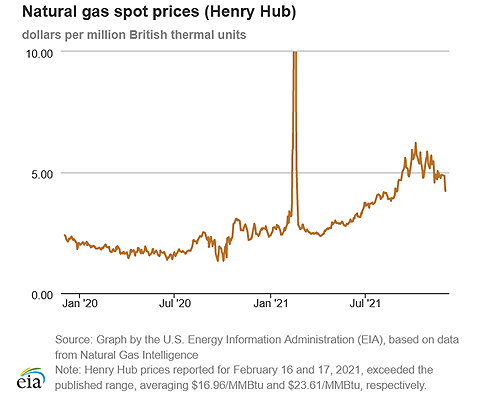
| Spot Prices ($/MMBtu) | Thu, 25-Nov |
Fri, 26-Nov |
Mon, 29-Nov |
Tue, 30-Nov |
Wed, 1-Dec |
|---|---|---|---|---|---|
| Henry Hub | Holiday | Closed | 4.86 | 4.51 | 4.23 |
| New York | Holiday | Closed | 5.71 | 4.39 | 3.88 |
| Chicago | Holiday | Closed | 4.73 | 4.14 | 3.94 |
| Cal. Comp. Avg,* | Holiday | Closed | 4.81 | 4.42 | 4.28 |
| Futures ($/MMBtu) | |||||
| December Contract | Holiday | 5.447 | Expired | Expired | Expired |
| January Contract | Holiday | 5.477 | 4.854 | 4.567 | 4.258 |
| February Contract | Holiday | 5.364 | 4.768 | 4.506 | 4.188 |
| *Avg. of NGI's reported prices for: Malin, PG&E Citygate, and Southern California Border Avg. | |||||
| Source: NGI's Daily Gas Price Index | |||||
| Spot Prices ($/MMBtu) | Thu, 18-Nov |
Fri, 19-Nov |
Mon, 22-Nov |
Tue, 23-Nov |
Wed, 24-Nov |
|---|---|---|---|---|---|
| Henry Hub | 4.98 | 4.90 | 4.77 | 4.90 | 4.90 |
| New York | 4.91 | 4.80 | 7.30 | 4.91 | 5.26 |
| Chicago | 4.81 | 4.82 | 4.61 | 4.70 | 4.80 |
| Cal. Comp. Avg,* | 5.98 | 5.67 | 5.20 | 5.42 | 5.06 |
| Futures ($/MMBtu) | |||||
| December Contract | 4.902 | 5.065 | 4.789 | 4.967 | 5.068 |
| January Contract | 4.995 | 5.145 | 4.861 | 5.035 | 5.114 |
| *Avg. of NGI's reported prices for: Malin, PG&E Citygate, and Southern California Border Avg. | |||||
| Source: NGI's Daily Gas Price Index | |||||
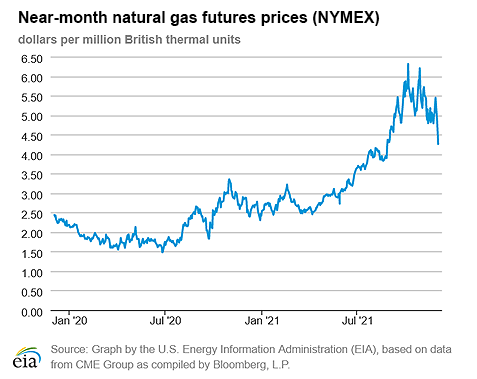
| U.S. natural gas supply - Gas Week: (11/25/21 - 12/1/21) | |||
|---|---|---|---|
Average daily values (billion cubic feet) |
|||
this week |
last week |
last year |
|
| Marketed production | 107.7 |
106.6 |
103.6 |
| Dry production | 96.0 |
95.1 |
92.0 |
| Net Canada imports | 5.3 |
5.1 |
4.3 |
| LNG pipeline deliveries | 0.1 |
0.1 |
0.1 |
| Total supply | 101.4 |
100.3 |
96.4 |
|
Source: Chart by the U.S. Energy Information Administration (EIA), based on data from IHS Markit | |||
| U.S. natural gas consumption - Gas Week: (11/25/21 - 12/1/21) | |||
|---|---|---|---|
Average daily values (billion cubic feet) |
|||
this week |
last week |
last year |
|
| U.S. consumption | 82.1 |
81.8 |
78.8 |
| Power | 27.7 |
28.7 |
25.8 |
| Industrial | 24.1 |
24.0 |
23.9 |
| Residential/commercial | 30.3 |
29.1 |
29.1 |
| Mexico exports | 5.4 |
5.2 |
5.6 |
| Pipeline fuel use/losses | 6.9 |
6.9 |
6.6 |
| LNG pipeline receipts | 12.0 |
11.6 |
10.0 |
| Total demand | 106.3 |
105.5 |
101.1 |
|
Source: Chart by the U.S. Energy Information Administration (EIA), based on data from IHS Markit | |||
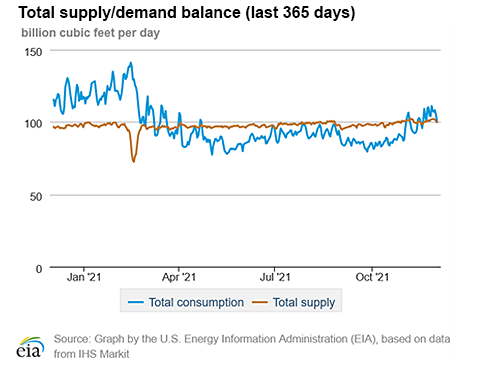
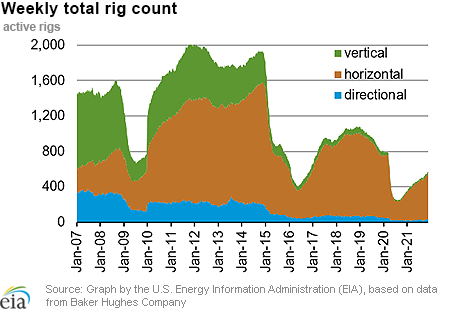
| Rigs | |||
|---|---|---|---|
Tue, November 23, 2021 |
Change from |
||
last week |
last year |
||
| Oil rigs | 467 |
1.3% |
93.8% |
| Natural gas rigs | 102 |
0.0% |
32.5% |
| Note: Excludes any miscellaneous rigs | |||
| Rig numbers by type | |||
|---|---|---|---|
Tue, November 23, 2021 |
Change from |
||
last week |
last year |
||
| Vertical | 22 |
0.0% |
46.7% |
| Horizontal | 513 |
1.4% |
81.3% |
| Directional | 34 |
-2.9% |
54.5% |
| Source: Chart by the U.S. Energy Information Administration (EIA), based on data from Baker Hughes Company | |||
| Working gas in underground storage | ||||
|---|---|---|---|---|
Stocks billion cubic feet (Bcf) |
||||
| Region | 2021-11-26 |
2021-11-19 |
change |
|
| East | 867 |
889 |
-22 |
|
| Midwest | 1,043 |
1,066 |
-23 |
|
| Mountain | 206 |
210 |
-4 |
|
| Pacific | 263 |
262 |
1 |
|
| South Central | 1,185 |
1,197 |
-12 |
|
| Total | 3,564 |
3,623 |
-59 |
|
|
Source: U.S. Energy Information Administration Form EIA-912, Weekly Underground Natural Gas Storage Report | ||||
| Working gas in underground storage | |||||
|---|---|---|---|---|---|
Historical comparisons |
|||||
Year ago (11/26/20) |
5-year average (2016-2020) |
||||
| Region | Stocks (Bcf) |
% change |
Stocks (Bcf) |
% change |
|
| East | 934 |
-7.2 |
875 |
-0.9 |
|
| Midwest | 1,124 |
-7.2 |
1,058 |
-1.4 |
|
| Mountain | 240 |
-14.2 |
218 |
-5.5 |
|
| Pacific | 318 |
-17.3 |
300 |
-12.3 |
|
| South Central | 1,324 |
-10.5 |
1,198 |
-1.1 |
|
| Total | 3,939 |
-9.5 |
3,650 |
-2.4 |
|
| Source: U.S. Energy Information Administration Form EIA-912, Weekly Underground Natural Gas Storage Report | |||||
| Temperature – heating & cooling degree days (week ending Nov 25) | ||||||||
|---|---|---|---|---|---|---|---|---|
HDDs |
CDDs |
|||||||
| Region | Current total |
Deviation from normal |
Deviation from last year |
Current total |
Deviation from normal |
Deviation from last year |
||
| New England | 184 |
6 |
11 |
0 |
0 |
0 |
||
| Middle Atlantic | 182 |
12 |
27 |
0 |
0 |
0 |
||
| E N Central | 202 |
7 |
43 |
0 |
0 |
0 |
||
| W N Central | 201 |
-18 |
35 |
0 |
0 |
0 |
||
| South Atlantic | 142 |
26 |
38 |
10 |
-1 |
-2 |
||
| E S Central | 143 |
23 |
48 |
0 |
-1 |
0 |
||
| W S Central | 65 |
-19 |
25 |
5 |
0 |
-11 |
||
| Mountain | 157 |
-33 |
15 |
1 |
1 |
-4 |
||
| Pacific | 74 |
-23 |
-11 |
0 |
-1 |
0 |
||
| United States | 150 |
-3 |
25 |
3 |
0 |
-2 |
||
|
Source: Chart by the U.S. Energy Information Administration (EIA), based on data from the National Oceanic and Atmospheric Administration Note: HDDs=heating degree days; CDDs=cooling degree days | ||||||||
Average temperature (°F)
7-day mean ending Nov 25, 2021
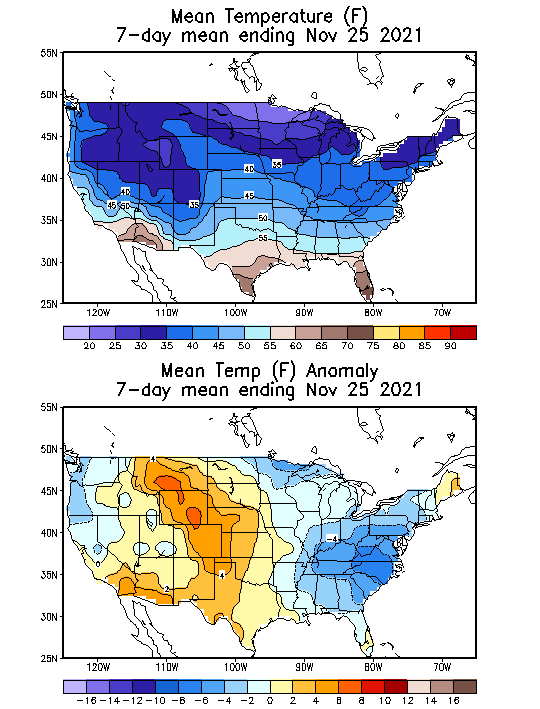
Source: National Oceanic and Atmospheric Administration
Deviation between average and normal (°F)
7-day mean ending Nov 25, 2021

Source: National Oceanic and Atmospheric Administration

